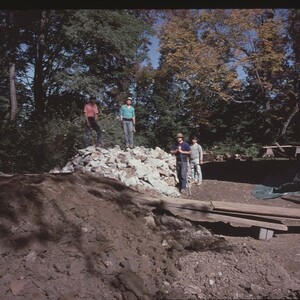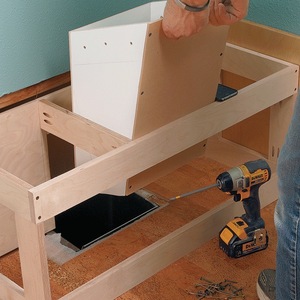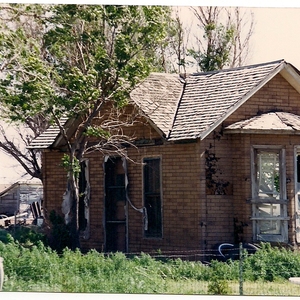I’m currently remodeling a 100yr old carrage house(approx60’x85′) the foundation is stacked stone and is in very good condition. however I can’t say the same for the sill plates or some of the studs and a couple of the corner posts. Approx. 60%percent of the sill is completely rotted the other 40% had been repaired (Icant call it that without shaking my head!)with get this tripled up doug fir untreated 2×4! As far as the wall studs are concerned much of them are rotted about 16″up. the same goes for the corner posts,my question is ; what technique is recomended I have acouple of ideas one of which involves using block and bringing up the foundation to where there is meat (about 16′) minus a new p.t. double 2×6 plate. or is sistering amore logical solution?Ive used this method for repairs never on entire footprints, all of the siding needs to come off which is a plus,and I failed to mention there is a substantial load an entire second fl. with living space. If I were to sister is it neccesary to go to the top plate or is half way sufficient. THANKS FOR LISTENING


















Replies
If you have a substantial second floor you should get an engineer to look at it for you. At a minimum, you should sister or replace the studs from sill to top-plate. Half-way sistering is not the way to go.
HTH,
Andy
With all that rot, I'm guessing the sills are pretty close to grade. This was a common design (and problem) for old outbuildings.
How about cutting off the lower (rotted) section, creating a new sill higher up, then raising the foundation to meet the new sill. Could consider a new poured or block foundation while the wall is 'out of the way'.
Or, if the stone aesthetic is important: use a heavy sill, and place piers or posts spaced appropriately to level and support structure, then infill with stone.
This method may actually be easier than repairing the sills in place, raises the grade, and gives you a chance to level the building.
Just an idea...
Thanks to both replies so far. I wasn't thrilled when someone told me 5' or so is fine thats why I thought the top plate was the way to go(the traditional sistering method) but I really like the idea of bringing the foundation up (your correct the sills are at grade level) and as far as an engineer goes I'll save him for last right now I would appreciate some pro's and con's and maybe some other techniques Thanks again
These pix might offer a suggestion for a method to prop the structure while you make repairs, whatever way you choose to go. I had plaster on the inside which I hoped to save. So I stripped the old siding, rewired and insulated, and then sheathed the wall to rack it and tie each stud into relative position to its neighbor. I left the sheathing off the bottom 2' so that I could my temporary ledger directly into studs and to leave access for attaching my new mudsill. I believe you could still do this and drop your sister studs in behind the ledger.
Tim,
Thanks for the pics.
I noticed that the new footing was poured completely outside of the old sill.
How did you set the building down on it?
I had to look at the pictures again to understand your comment. It does appear that the new footing is not underneath the mudsill, but that is not the case. It is directly under there. However, it was poured wide and to the outside for the following reason. Occasionally, I put a 6x6 crosswise to the mudsill on house jacks to raise the house a bit so that I could lay my last row of blocks. The wide footing is so that I would have a solid place to set the house jacks. After I got the house set back on the new blocks, I'd remove the jacks and the 6x6, and set in the remaining blocks.
You might have a house mover look at the problem. They could lift the whole building up out of the way so you could do all the foundation work in one pass, and then put it back down for you. You could even put the house in a higher final position to get a nice big crawl space. Sistering does need to be the whole length of the stud.
-- J.S.
Thanks for the pics nice job!And I do agree about the sistering the entire length, but I'm really thinking about raising the sills a foot or so above grade the wall support pic convienced me, I'm not looking to raise the structure, and the existing siding is going too! should I use block or do a pour?The existing foundation is stone (mortared) The above grade astetics are not much of a concern, Thanks to all so far.
Raising the structure is troublesome for doors openings, windows, utilities and such.
Cutting off the bottom seems easier, particularly for structures with no attached floor to deal with.
Pour is probably better, but blocks are easier to deal with for this sort of thing, IMHO. You could even potentially do one section at a time with blocks. Blocks are best for someone working mostly alone.
If the stones have decent footing, and are in solid shape, you could potentially use heavy sills to spread the load (just in case), and build with block on top of them.
I have a carraige house that needs the same treatment, if I can ever get to it...
Best of luck
Thank for all your input Iam awaiting a structural engineer's arrival next week I hope he supports (no pun intended) my theory on raising the footings I will keep you all aprised ,Thanks again.
POLYURETHANE
Hi Poly......
Some hate the name Norm Abrams with a passion but I watch his shows frequently. He and Tom Silva have repaired rotting sillplates a few times on their TV show "This Old House". They used a few different techniques, depending on the extent of the problem and the type of foundation.
I'm sure that if you contact them at the website they will probably be able to sell you a helpfull show segment. I don't think the segments are that expensive, I've never bought one but the segments I've seen on rotting sillplates are quite descriptive.
Ed